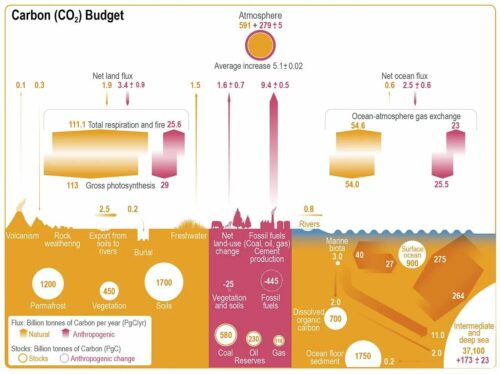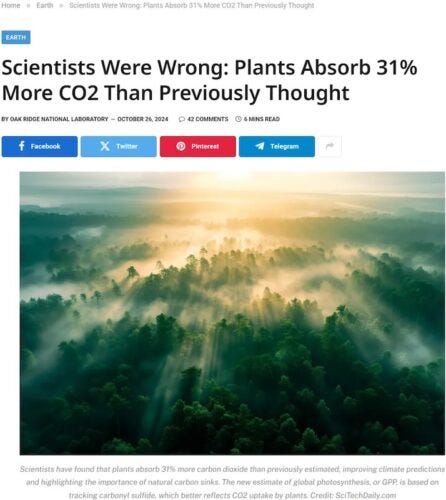HEADLINE: “New Evidence Questions Humanity’s Role In The Carbon Cycle”, by Dr. Matthew Wielicki
“Climatologist raises doubts about man-made CO2 causing climate change.”
New Evidence Questions Humanity’s Role In The Carbon Cycle
Climatologist raises doubts about man-made CO2 causing climate change.
in Energy, News and Opinion, Science
Reading Time: 4 mins read
A A
Share on FacebookShare on XwitterShare on Linkedin
Questioning the Fundamental Basis of Climate Science and Policy
As an isotope geochemist, I’ve spent years studying the subtle signatures that reveal Earth’s hidden stories. Isotopes, variants of elements like carbon, act as chemical fingerprints, tracing the movement, age, and origin of materials through time. [emphasis, links added]
They don’t lie, and they don’t bend to narratives.
Early in my career, I was struck by the Suess Effect, a shift in atmospheric carbon isotopes that seemed to pin the rise in CO2 squarely on fossil fuel combustion.
The evidence was compelling: burning ancient coal and oil, devoid of radiocarbon (¹⁴C) and depleted in ¹³C, was diluting the atmosphere’s isotopic ratios. It didn’t make me fear catastrophic climate change, but it convinced me that humans were reshaping the atmosphere.
Now, I’m not so sure.
Recent discoveries and lingering contradictions suggest the story isn’t as clear-cut as we’ve been told.
At the heart of climate science lies a critical assumption: we fully understand the carbon cycle, the complex dance of carbon through air, oceans, plants, soils, and rocks.
This assumption underpins every climate model, policy, and trillion-dollar investment. But what if the foundation is shakier than we thought? What if nature is playing a larger role in rising CO2 than we’ve accounted for?
Let’s explore the cracks in this narrative and ask a critical question: Are we really responsible for the carbon in the atmosphere?
Cracks in the Foundation
The carbon cycle is Earth’s grand accounting system, tracking how carbon moves between vast reservoirs: the atmosphere (850 petagrams of carbon, PgC), oceans (38,000 PgC), soils, vegetation, and fossil fuels.
According to the IPCC’s Sixth Assessment Report (AR6, Working Group 1, Chapter 5), natural processes like photosynthesis, respiration, and ocean-atmosphere exchange shuffle hundreds of gigatons of carbon annually, orders of magnitude more than human activity, which adds roughly 9.5 PgC per year through fossil fuel combustion and land-use changes.
Figure 5.12 in the IPCC report illustrates this beautifully, with yellow arrows showing natural fluxes and pink arrows marking human contributions. The deep ocean alone holds 40 times more carbon than the atmosphere, and natural fluxes dwarf our emissions.

This isn’t to say human emissions are trivial. Even a small imbalance can tip the scales, gradually increasing atmospheric CO2. But the sheer scale of natural processes raises a question: How precisely do we understand these fluxes?
If our models miss even a fraction of nature’s contributions, the entire carbon budget, our estimate of sources and sinks, could be off. And with it, our confidence in attributing the CO2 rise solely to human activity.
The Isotope Fingerprint… and Its Smudge
The Suess Effect has long been climate science’s ace in the hole.
As fossil fuels burn, they release CO2 with no ¹⁴C (due to radioactive decay over millions of years) and less ¹³C than atmospheric CO2.
This dilutes the atmosphere’s isotopic ratios, a pattern observed since the Industrial Revolution. The IPCC cites this as definitive evidence that fossil fuels drive the CO2 increase, and I once agreed. The isotopic math seemed airtight.
But here’s the wrinkle: other natural sources can mimic this signature. Permafrost thawing in the Arctic releases ancient organic carbon, low in ¹⁴C and ¹³C. Petrogenic carbon from weathered sedimentary rocks does the same.
Deep ocean CO2, upwelled from centuries-old waters, carries a similar isotopic profile. These sources aren’t new, but their contributions are poorly quantified. If they’re larger than assumed, they could blur the line between “human” and “natural” CO2.
The Suess Effect remains strong evidence, but it’s not the unassailable fingerprint we once thought. Could we be overconfident in our attribution? (I discussed this in more detail in my article on the Suess Effect.)
Nature’s Lung Capacity… Bigger Than We Thought
Recent research deepens these doubts. A 2024 study in Nature Geoscienceused carbonyl sulfide (COS), a chemical absorbed by plants, to estimate global photosynthesis. (You can read more about that in my critique here.)
The result? Terrestrial ecosystems are soaking up 31% more CO2 than previously modeled. This suggests land plants are a more powerful carbon sink than we realized, which could shrink the net human contribution to atmospheric CO2.
If our models underestimated this sink, what else have we missed?

Irrational Fear is written by climatologist Dr. Matthew Wielicki and is reader-supported. If you value what you have read here, please consider subscribing and supporting the work that goes into it.
Read rest at Irrational Fear





Heavily researched does not guarantee correct. Even one erroneous assumption in common renders pages of references, papers and citations useless. CAGW’s GHE contains three such assumptions.
GHE claims without it Earth becomes 33 C cooler, a 255 K, -18 C, ball of ice.
Wrong.
Naked Earth would be much like the Moon, barren, 400 K lit side, 100 K dark.
TFK_bams09 heat balance graphic uses the same 63 twice violating GAAP and calculating out of thin air a 396 BB/333 “back”/63 net GHE radiative forcing loop violating LoT 1 & 2.
Wrong.
Likewise, the ubiquitous plethora of clones.
GHE requires Earth to radiate “extra” energy as a BB.
Wrong.
A BB requires all energy leaving the system to do so by radiation. Per TFK_bams09 60% leaves by kinetic modes, i.e. conduction, convection, advection and latent rendering BB impossible.
GHE is bogus and CAGW a scam so alarmists must resort to fear mongering, lies, lawsuits, censorship and violence.